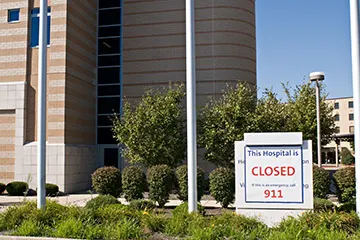Can we prevent Rural Health Hospitals from disappearing?

By Ibby Smith Stofer
Growing up in a small rural community access to healthcare was and continues to be challenging for many Americans.
In fact, over 25% of America’s population lives in what is considered by the census bureau to be rural
America. However, less than 10% of US physicians practiced in these communities according to a 2010 report by the
Office of Rural Health Policy. The projection of physician shortages varies from each source but as of 2014 and
independent firm IHS forecasted numbers ranging from 46 to 90+ thousands. Shortages combined with the challenges of
life in rural areas such as the lack of spousal employment opportunities, schools and lack of social and other
desired community attractions make it difficult to project a bright future for our rural hospital systems. In fact,
between 2010 and 2016, 80 rural hospitals (including 27 critical access hospitals) have shuttered their doors. That
leaves many without essential access to inpatient, outpatient, and emergency medical services in their communities.
Families living in the rural communities often drive several hours to reach the nearest hospital and it is no guarantee that the facility will be prepared to treat them. Emergency services often require air transport to a care center with the staff and capability to treat critically ill or injured patients. Cost of this type transport or the lengthy delay in reaching care can easily result in either compromising the outcome but also place the patient in severe financial hardship. Air transport costs vary based on distance as well as the level of care team required to treat the patient. It is often impossible for the patient or caregiver to know if it will be covered by their insurance or what the costs will be, but it is sometimes the only choice. Often, there may be one primary care physician within 50 to 100 miles and no specialist within a reasonable distance. This can and does result in delay or no care being sought by the patient and can lead to more costly complications.
Over half of the US hospitals are designated as rural or critical access facilities. However, the continued movement to more urban or suburban areas leaves no rural health hospital secure. The economy, the disappearance of local industries, living below the poverty levels, concentration of older residents and the lack of physician services have all been cited as reasons why so many rural facilities are closing. The trend is expected to continue with Obamacare’s replacement program.
Should the communities or the federal or state government be concerned and find a way to turn this around? What about the healthcare industry, can they help? The good news, if there is any in this story, is that telemedicine has shown that there are ways to improve access and quality of care. There are examples that demonstrate the many ways that telemedicine has and can help rural healthcare facilities slow if not stop the need for patients to “drive by” for better care.

Some of the ways telemedicine or telehealth is aiding efforts to slow and eliminate the disappearance of rural hospitals include providing remote radiology, psychiatry, ophthalmology, dermatology and dentistry. Utilizing tele technology, the rural providers and patients can connect to a specialist who can monitor the diagnosis and guide the on site staff. In the past this would have required air or ground transport or lengthy delays and travel to meet with a professional service provider.
Using telemedicine is not only convenient, most patients and providers rate the experience as very successful for them and significantly improve their satisfaction with the nearby healthcare provider that has implemented the service to meet their patients needs.
Telemedicine is also utilized in larger hospitals and outside the physical buildings. Monitoring of at home vital signs, chronic disease states, and x-rays or scans done outside the hospitals are all linked via the progress telemedicine has made over the last twenty or so years.
Clearly by allowing the smaller facilities access to specialists from both the clinical and patient view has enabled many to offset the demise of the rural hospital. From Alaska to Florida, or from Hawaii to New York and most everywhere in between one of more forms of telemedicine are contributing to the quality and cost reduction initiatives and perhaps more importantly, are providing higher patient satisfaction.
Expansion and acceptance of nurse practitioners and physician assistants to perform many of the clinical diagnosis, and treatment is another way in which services to the rural population. The projected shortage of physicians and specialist in both rural and urban settings may benefit from this trend as more patients are finding these professionals competent and accessible.
Hopefully, more technology and innovation will aide in ensuring quality and affordable care remains in the neighborhood as well as in the cities. America needs both. All of us need to offer any ideas and suggestions we have to prevent the disappearance of these care centers. What are your ideas?
Sources:https://www.aamc.org/
